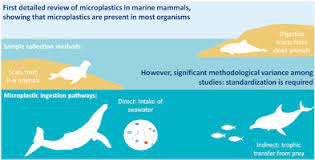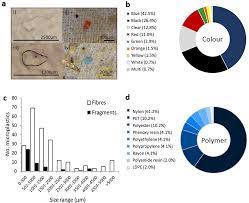Alarming findings regarding the prevalence of microscopic plastic particles in the fats and lungs of marine mammals have come to light in a ground-breaking study by a graduate student at Duke University Marine Lab. This study raises significant concerns about the potential impacts of microplastics on these majestic creatures, shedding light on yet another challenge they face in an increasingly polluted and changing ocean environment. Microplastics discovered in tissues of whales and dolphins

Microplastics: A Hidden Menace
The study, slated for publication in the Environmental Pollution journal, reveals that two-thirds of the marine mammals surveyed were found to have microscopic plastic particles embedded in their tissues. These microplastics appear to have travelled beyond the digestive tract, suggesting that they can lodge themselves in vital organs and tissues. Although it is still unclear how much harm these embedded microplastics will cause, previous research has suggested that they might act as endocrine disruptors and hormone mimics.
The study’s methodology
The samples used in this study were collected from 32 stranded or subsistence-harvested marine mammals between 2000 and 2021, spanning regions from Alaska to California and North Carolina. Twelve different species were represented in the study, highlighting the widespread presence of microplastics in marine mammals. Notably, even a bearded seal, a species vital to Arctic ecosystems, was found to have plastic in its tissues.
How Microplastics Infiltrate Marine Mammals
Plastics are lipophilic, meaning they are attracted to fats. This makes blubber, the melon on a toothed whale’s forehead, and fat pads along the lower jaw vulnerable to plastic infiltration. The study analyzed four types of tissues: blubber, the sound-producing melon, fat pads, and the lungs, and found microplastics in all of them. The size of the plastic particles ranged from 198 microns to 537 microns, which can cause physical damage to tissues in addition to any chemical threats they pose.
The Ongoing Investigation
Research is now focused on understanding the metabolic impact of these microplastics on marine mammals. Toxicology tests involving plastic particles are planned, utilizing cell lines grown from biopsied whale tissue. The most common types of microplastics found in the tissues were polyester fibers and polyethene, which is commonly found in beverage containers.
The Larger Implications
Marine mammals may not only ingest microplastics directly but may also acquire them indirectly through the animals they prey on, creating a potential pathway for plastic accumulation up the food chain. This issue underscores the pervasive nature of ocean plastics and their long-term consequences. Some samples used in this study date back to 2001, indicating that microplastics have been infiltrating marine mammals for at least two decades.

The findings of this study serve as a stark reminder of the urgent need to address the issue of plastic pollution in our oceans. As marine mammals face multiple threats, including climate change, pollution, and noise, the discovery of microplastics in their tissues adds another layer of concern. Collaborative efforts among scientists, policymakers, and the public are essential to mitigate this growing threat to marine life and our planet’s oceans.
For more information read this article: https://www.nature.com/articles/s41598-018-37428-3
This research was made possible through the support of the National Science Foundation, the North Carolina Wildlife Federation, and the North Carolina Sea Grant.
Read our previous articles: Utilizing 239 Million-Year-Old Fossils to Enhance the Search for Martian Aliens
https://scitechupdate.com/index.php/android-14-satellite-sms-for-everyone/
https://scitechupdate.com/index.php/chemistry-entrepreneurship/
https://scitechupdate.com/index.php/waste-paper-to-battery-components-for-smarts-phones-vehicles/https://scitechupdate.com/index.php/ai-demonstrated-95-accuracy-in-listening-typing-and-data-processing/
https://scitechupdate.com/index.php/top-7-technology-trends-of-2023-from-ai-to-5d-technology/







